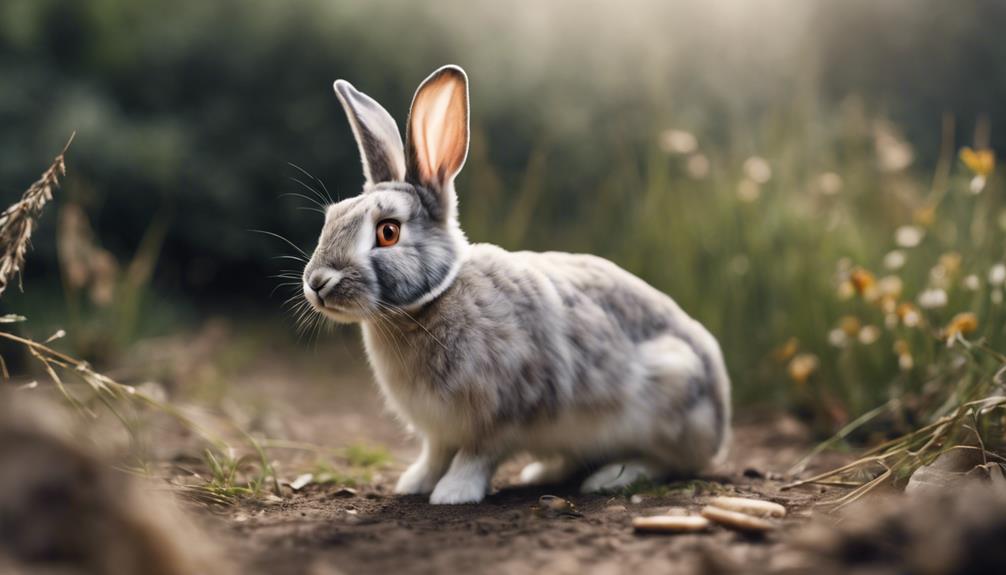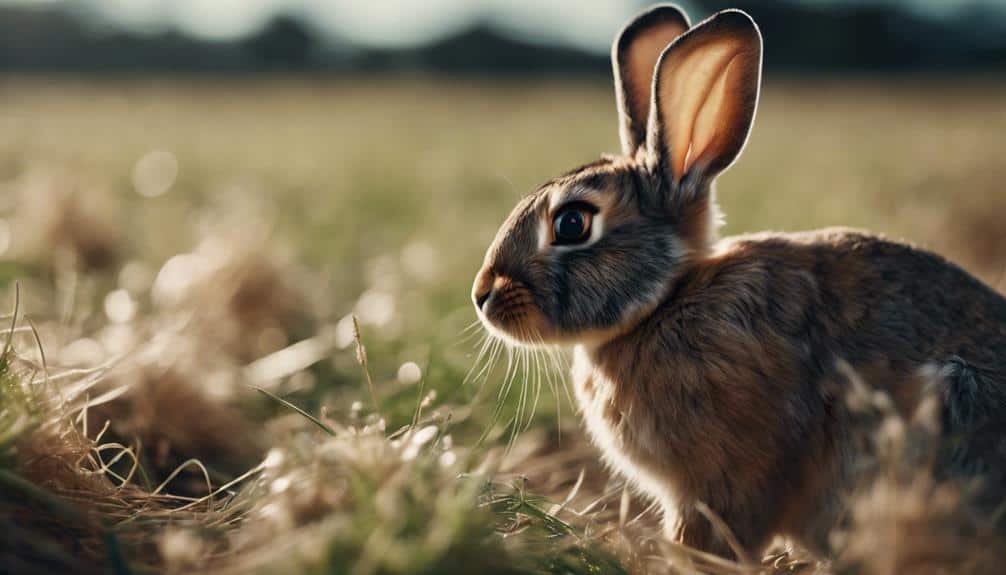Rabbits do have a pretty wide field of vision, which helps them keep an eye on their surroundings. But can they really spot those hawks just waiting to pounce?
The thing is, rabbits don't exactly have the best eyesight. They can see pretty well up close, but their distance vision isn't that great.
Hawks, on the other hand, are experts at flying high and spotting prey from a distance.
So, can rabbits see hawks? The answer is, it depends. If a hawk is flying really low or is close enough, a rabbit might be able to spot it. But if the hawk is flying high, the rabbit probably won't be able to see it until it's too late.
Rabbits have other ways of detecting predators, like hearing and smelling, but their eyesight isn't their strongest sense.
Contents
Key Takeaways
So, can rabbits see hawks? The answer is yes, they can. One reason is because of their wide visual field, which helps them detect potential threats like hawks.
Rabbits also use a technique called parallax to estimate how far away predators are. This is especially helpful when it comes to hawks, which can be sneaky and fly in quickly. By using parallax, rabbits can get a sense of how far away the hawk is and plan their escape accordingly.
Hawks have distinct movements and flight patterns that rabbits are sensitive to. Rabbits are able to pick up on these cues, which helps them detect hawks more effectively. Additionally, their eyes are adapted to function well in low light conditions, making it easier for them to spot hawks even when it's not bright outside.
It's worth noting that rabbits prioritize detecting predators like hawks over having perfect vision. In other words, they're more concerned with staying safe than with seeing every detail clearly. This makes sense, considering that their survival depends on it!
Rabbit Visual Field

Rabbits have an amazing visual field that covers almost 360 degrees. This is because their eyes are positioned on the sides of their heads, giving them a really broad view of their surroundings. This is super important for detecting potential threats, like predators, and helps them stay safe.
One limitation of their visual field is that they've a 10-degree blind spot right in front of their nose and under their chin. To get around this, rabbits constantly move their heads and eyes to scan their environment really thoroughly.
Now, you might think that having eyes on the sides of their heads would mean they've a lot of overlap in their fields of vision, but that's not the case. Instead, they use a trick called parallax to help them figure out distances, kind of like birds do.
This unique visual system is all about helping them survive in the wild and avoid predators.
Rabbits can even see above their heads, which helps them detect aerial predators like hawks. Their ability to perceive movement and changes in their environment is really sharp, and it's essential for their survival instincts and natural behavior.
Predator Detection Abilities
Rabbits have some amazing abilities to detect predators, and one of the most impressive is their wide vision range. They can see almost 360 degrees around them, which helps them spot hawks and other aerial predators from a distance.
This incredible vision is crucial for rabbits to detect potential threats from the air. They can monitor a huge area, scanning the skies for any sign of danger.
By understanding how rabbits use their visual abilities to detect predators, we can learn more about the fascinating adaptations that have evolved in prey species.
It's worth noting that rabbits have developed specific strategies to spot hawks, which are one of their main predators. By studying these strategies, we can gain a deeper appreciation for the incredible ways that rabbits have adapted to their environment.
Rabbit Vision Range
So, how do rabbits' eyes help them detect predators? For starters, their eyes are positioned on the sides of their head, giving them a nearly 360-degree field of vision. This wide view allows them to spot predators like hawks from various angles, which helps them stay safe in the wild.
However, there is a catch – rabbits do have a 10-degree blind spot directly in front of their nose and under their chin. But their visual system is really good at detecting movement and changes in their surroundings, making them more likely to notice a hawk's movement rather than its stationary presence.
Rabbits also use a technique called parallax to gauge distance, which helps them detect predators at different distances. Plus, they're farsighted, so they can see objects – including potential threats like hawks – from 10-15 feet away.
Here are some key characteristics of a rabbit's vision range:
| Rabbit Vision Range Characteristics | |
|---|---|
| Field of Vision | Nearly 360 degrees |
| Blind Spot | 10-degree area in front of nose and under chin |
| Distance Detection | Up to 10-15 feet away |
Hawk Detection Strategies
Rabbits have a clever way of detecting hawks from various angles, especially in the airspace above them. With eyes on the sides of their heads, they're always on the lookout for movement and changes in their surroundings to spot potential aerial threats like hawks.
One of the ways they do this is by using parallax, similar to birds, to help gauge distances and track the approach of predators. This is especially useful since they've limited binocular vision. They're also super sensitive to rapid flight patterns, which helps them detect the swift movements characteristic of hawks.
What's more, rabbits can see really well in low light conditions, which enhances their predator detection capabilities. This is especially important during dawn and dusk when hawks are most active. By combining their wide field of vision, sensitivity to motion, and adaptations for low light visibility, rabbits have developed effective hawk detection strategies to boost their chances of survival in the face of aerial threats.
Hawk Detection Mechanisms

Rabbits have developed some impressive ways to detect hawks in their surroundings. For starters, they've nearly 360-degree vision, which means they can spot predators like hawks from almost any angle – even above their heads.
Now, you might think that having eyes on the sides of their heads would limit their ability to judge distances. But rabbits have found a way around this. They use a technique called parallax, which is similar to what birds do. This allows them to estimate distances and identify potential threats like hawks.
Rabbits' eyes are also adapted to help them see well in low light conditions. They've a higher ratio of rods to cones in their retinas, which is great for detecting movement but not so great for getting a clear visual image of a hawk. And that's okay, because rabbits prioritize detecting movement and changes in their environment over getting a sharp image. This helps them respond quickly to potential threats like hawks.
Rabbit Eye Positioning
Rabbit eye positioning is pretty important for their visual abilities.
With eyes on the sides of their head, rabbits can see a lot around them, which helps them quickly spot potential threats like predators.
This unique eye positioning affects how rabbits perceive their surroundings and helps them with their survival instincts.
Eye Positioning Affects Vision
Rabbits have a pretty cool way of seeing the world. Their eyes are positioned on the sides of their head, which gives them a huge field of vision. They can basically see almost 360 degrees around them, which helps them detect predators coming from different angles.
But there's a catch – because their eyes are on the sides, they've a small blind spot right in front of their nose and under their chin. It's only about 10 degrees, but it's still a limitation. However, their wide field of vision makes up for it, and they're still really good at spotting predators.
One thing that's a bit tricky for rabbits is judging distances. Because their eyes don't overlap much, they've limited 3D vision. Instead, they use something called parallax to figure out how far away things are. This means they move their head or body to get a sense of depth.
It's all about priorities, and for rabbits, detecting predators is way more important than seeing every little detail. Their eye arrangement is set up to help them survive in the wild, and it does a great job. By being able to see threats from all directions, rabbits can focus on finding food and staying safe at the same time.
Predators Spotted Quickly
Rabbits have a remarkable ability to quickly spot predators approaching from various angles. This is because their eyes are positioned on the sides of their head, giving them a wide field of vision.
This unique eye positioning allows them to detect predators swiftly, including aerial threats like hawks. Although they've limited 3D vision and a small blind spot in front of their noses, they rely on their peripheral vision to stay vigilant against potential dangers.
Rabbits prioritize detecting movement and changes in their surroundings over having clear vision. This makes them adept at spotting predators quickly.
Rabbits' eye positioning on the sides of their head enables them to see nearly 360 degrees, allowing them to detect predators quickly. Their limited 3D vision actually helps them detect threats rapidly. They use their peripheral vision to stay vigilant against potential dangers, which aids them in spotting aerial predators like hawks.
Sensitivity to Movement

Rabbits are super sensitive to even the slightest movements around them. This is a huge advantage when it comes to staying alive. They can detect potential threats and react fast, which helps them survive. Rabbits are not only aware of their immediate surroundings; their keen senses allow them to pick up on sounds and smells that humans might overlook. This heightened sensitivity is especially crucial for rabbits living outside their cages, where they are more exposed to predators. Their ability to quickly assess danger and seek shelter can mean the difference between life and death in the wild.
One reason they're so good at noticing movement is because of their impressive depth perception. Their eyes are on the sides of their head, giving them a wide field of view. This helps them see motion across a big area, making it easier for them to spot predators or dangers coming from different directions.
Rabbits are also great at telling the difference between things that are standing still and things that are moving. This helps them quickly identify potential threats, like a hawk flying overhead or a predator sneaking up. By picking up on even the tiniest movements, they can quickly take action to stay safe, like running away or hiding. This sensitivity to movement is a key way for rabbits to defend themselves in the wild and stay alive.
Adaptation to Spot Threats
Rabbits have amazing eyesight that helps them detect threats in their environment. They can see almost 360 degrees around them, which is really helpful for spotting predators like hawks.
Now, you might think that's perfect, but there's a catch – they've a 10-degree blind spot right in front of their nose and under their chin. But don't worry, they can still sense movement in that area.
The way they use something called parallax, similar to birds, helps them figure out how far away a threat is. This is super important for avoiding predators. Their visual system is designed for survival, not for seeing things clearly. They prioritize detecting predators over having perfect vision.
Rabbits position their eyes in a way that helps them detect movement and changes in their surroundings. This means they're more likely to spot a hawk suddenly appearing or moving. This adaptation ensures they can react quickly to potential threats, even if they can't see them clearly.
Limitations in Color Perception

Rabbits have limited color perception due to their partial color blindness and the way their retinas are structured. They can only tell the difference between blue and green wavelengths, which is a pretty restricted range. This is because they've only two types of cones in their retinas, whereas humans have three.
This limitation makes sense when you consider their natural habitat, where shades of green and blue are the most common. So, even though they can't see the full range of colors like humans do, their color vision is still useful for their survival. Plus, they're really good at recognizing individuals and detecting movement, even if they can't see every color.
Rabbits also rely heavily on their other senses, like smell and hearing, to help make up for their visual limitations. So, even though they don't see the world in the same way as humans, they're still well adapted to their environment.
Response to Predators
Rabbits have a pretty impressive field of vision, almost 360 degrees, which helps them detect predators like hawks from a wide angle.
However, they do have a 10-degree blind spot right in front of their nose and under their chin, which could make it tough for them to spot a hawk directly in front of them.
To get around this, rabbits rely on their peripheral vision to sense movement and changes in their surroundings.
This allows them to react quickly to potential threats from predators like hawks.
Rabbits are most active during dawn and dusk, which just so happens to be when their visual system is at its best.
This coincides with peak hunting times for hawks.
Rabbits prioritize detecting motion and changes in their environment over seeing fine details.
This means they can react quickly to the presence of predators like hawks rather than focusing on getting a clear view.
This heightened awareness and quick response mechanism are crucial for their survival when faced with predators like hawks.
Conclusion
So, can rabbits see hawks? The answer is yes, they can. In fact, rabbits have a remarkable ability to detect hawks and other predators.
Their eyes are positioned on the sides of their heads, which gives them a wide visual field. This allows them to spot aerial predators like hawks from a distance. Rabbits are also very sensitive to movement, which helps them detect potential threats.
It's not just about seeing the hawk, though – rabbits have also adapted to spotting threats. They've a keen sense of predator detection, which makes them well-equipped to evade danger. In short, when it comes to rabbit vision, hawks don't stand a chance against their sharp eyes and quick reflexes.






